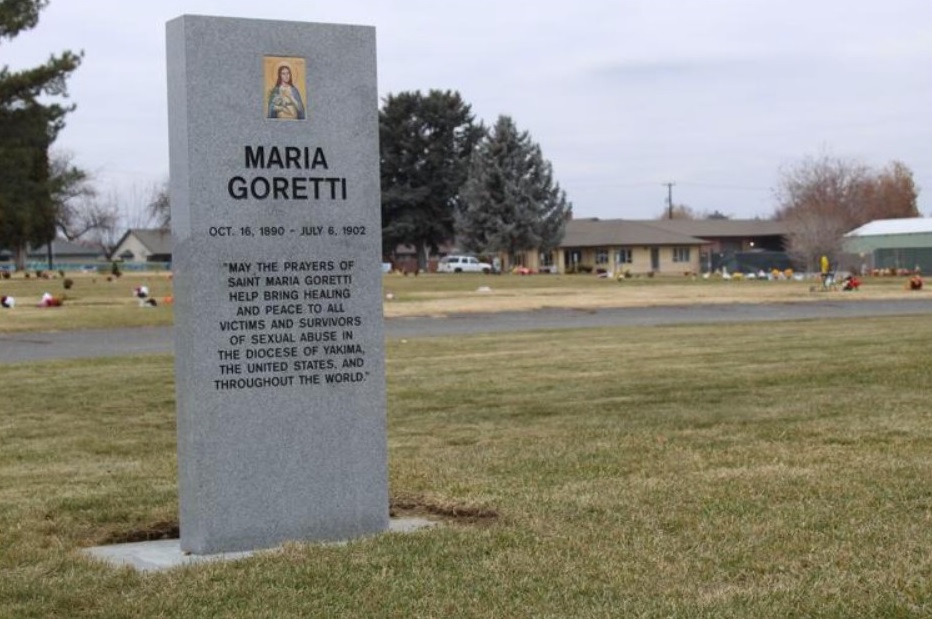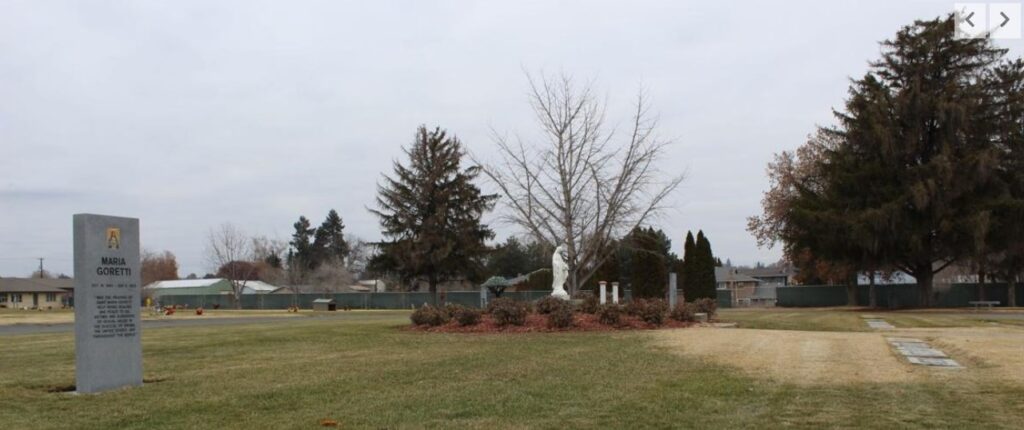YAKIMA (WA)
Yakima Herald-Republic [Yakima WA]
December 17, 2023
By Joel Donofrio
A new memorial stone in Yakima’s Calvary Catholic Cemetery is meant to prompt “quiet reflection and prayer” for clergy sex abuse victims.
It also has generated criticism from statewide victims’ advocates and a demand to update the list of diocesan sex offenders.
Yakima Bishop Joseph Tyson dedicated the monument, which honors the Catholic Church’s St. Maria Goretti, during a brief ceremony on All Souls Day, the church’s Nov. 2 celebration honoring and praying for faithful Catholics who have died.
The granite memorial, on the south end of the diocesan cemetery’s clergy circle where 25 priests and one bishop are buried, includes an icon of the saint and a prayer for healing for all victims of abuse in the Diocese of Yakima, the United States, and throughout the world, the diocese said in a news release.
“While not specifically addressing abuse by clergy, its placement in the Priests Plot at Calvary acknowledges the scandal of abuse in the Catholic Church and the loss of faith that has accompanied it,” the diocese stated.
The placement of the monument in the centrally-located clergy area of the cemetery came roughly a year and a half after former Yakima resident Michael Ross, who was abused as a junior high student in the late 1960s, requested the removal of an acknowledged abusive priest from the priests’ plot.
Diocesan officials denied his April 2022 request to remove Monsignor Joseph Sondergeld’s remains from the clergy area. The diocese’s Monsignor Robert Siler told the Yakima Herald-Republic this week that the new monument’s placement was not a direct response to Ross’ request.
“Mr. Ross’ complaints in 2022 did not trigger getting plans together for the memorial at Calvary, but it certainly reminded me that a memorial that was universal in scope would be a good addition to our cemetery,” said Siler, who serves as episcopal vicar and moderator of the Curia for the Yakima Diocese.
Siler is the diocesan official who oversees the Safe Environment Training Program to prevent future sexual, physical or emotional abuse of children in the Yakima diocese’s churches and schools. In that role, he authorized the creation and placement of the Calvary Cemetery monument.
“It’s something we have considered for several years,” Siler said, noting an icon of St. Maria Goretti and a plaque with similar wording was dedicated eight years ago at Our Lady of Fatima parish in Moses Lake.
“Placement of the marker in the section of the cemetery set apart for clergy does acknowledge the tragic history of abuse in the Catholic Church,” he added. “The Church has implemented effective programs to prevent abuse or lessen its impact. And we continue to assist victims and survivors.”

SNAP demands investigation, disclosure of more abusers
Two Washington residents associated with the state’s Survivors Network of People Abused by Priests believe differently, and sent a letter to Tyson demanding a public display on which the diocese named both clergy and lay ministers who sexually abused children.
The SNAP representatives, including former Diocese of Yakima employee Robert Fontana, also want at least 12 abusers added to the diocesan website’s online list of clergy and ministers who have credible allegations of abuse.
That list, created in 2019 and most recently updated in October, identifies priests and deacons with substantiated allegations of sexual abuse of a minor during their ministries within Central Washington. The updated list includes 21 names, three of which are religious order priests who served in the diocese.
Besides Sondergeld, who died in 1969, the Rev. Anthony King is on the list of abusive priests and was buried in the priests’ plot following his death in 2001.
Fontana and Tim Law, director of the Seattle-based Ending Clergy Abuse organization, urged Tyson to add at least 10 names to the list of clergy based on credible accusations and acknowledgement of past sexual abuse of minors. Their list includes at least one other priest buried in the Calvary Cemetery clergy area. Their letter also asks the diocese to identify lay people who worked in parish ministry.
“The list that you published on the diocesan website of clergy and ministers who have credible allegations of abuse is woefully inaccurate,” the SNAP letter to Bishop Tyson states. “We know of at least another dozen names that ought to be on the public list.”
Fontana and Law’s letter was, in part, prompted by last month’s dedication of the Calvary Cemetery monument.
“It is insulting that you have placed a memorial to victims of clergy sex abuse … while continuing to respond inadequately to lingering issues related to clergy sex abuse, sexual misconduct and the cover-up of these activities,” the letter states.
They request that any clergy buried in diocesan cemeteries who have credible allegations of sexual abuse of a minor or vulnerable adult have “information posted next to the grave stating that this priest betrayed his priestly vocation and recounting the details of this betrayal.”
Fontana and Law also wrote that each parish in the diocese have a public display listing clergy and lay ministers who served in the parish and betrayed their vocations by sexually abusing children, youth and vulnerable adults.
“This display must include perpetrators’ photos and a description of the sexual abuse that occurred,” the letter states, adding that such a display at St. Paul Cathedral in Yakima would include “at the very least, seven priests and one layman.”
The letter’s final request is an independent agency’s review of diocesan files and abuse claims to both update the list of abusive priests, add lay ministers to the list and examine which current or former church supervisors ignored or protected those suspected of child sex crimes.

The diocese response to SNAP
Siler, the diocesan official and spokesperson, said he received a copy of SNAP’s letter Dec. 8. On Dec. 11, Siler issued a news release denying Fontana’s and Law’s claims.
“The diocese vigorously disputes all of Mr. Fontana’s claims, many of which have been raised by him repeatedly for nearly 20 years,” Siler wrote. “He, SNAP and similar groups have made various demands over that time period, with little or no standing to do so.
“Nonetheless, Bishop Tyson has referred the letter to the Diocesan Lay Advisory Board for discussion at its next meeting, for a recommendation for a possible response.”
Siler’s news release also included “some basic points for people of good will to consider,” including an acknowledgement that sexual abuse of children is a “persistent societal disorder” that requires education and solutions far beyond the Catholic Church.
“The Diocese would welcome, and be an active participant, in a statewide effort to study the history of sexual abuse of minors in all churches, schools, childcare centers and other organizations that serve children and youth, and to help victims and survivors still in need of assistance,” Siler stated.
He also wrote that the diocese believes its online list of priests and deacons accused of abuse provides sufficient information.
“In our view, the cemetery is a place for quiet reflection and prayer, not for the kind of details Mr. Fontana advocates being placed there,” Siler wrote.
“But if a statewide effort were to surface the names of thousands of abusers, or more, and recommended such announcements be made at their gravesites, we would likely take part.”
Who was Maria Goretti?
The Diocese of Yakima’s selection of St. Maria Goretti on its memorial to clergy sex abuse victims is tied to her background and example to “uplift the healing and peace that can come through forgiveness,” the diocese wrote in a news release.
Goretti was 11 years old when she refused the advances of an older farmhand, Alessandro Serenelli, in her Italian village. Serenelli then stabbed Goretti repeatedly, and she died of her wounds in a hospital several days later. She forgave her attacker and expressed her wish that he repent, the diocese reported in a newsletter announcing the memorial dedication at Calvary Cemetery.
“He underwent a profound conversion while serving a 30-year prison sentence, which included a vision of the saint offering him a gift of lilies that burst into flame,” the diocesan newsletter states, adding that Serenelli was present at the canonization Mass for Goretti in 1950.
The Calvary Cemetery memorial has an icon of Maria Goretti, her birth and death dates (Oct. 16, 1890 – July 6, 1902) and the words “May the prayers of Saint Maria Goretti help bring healing and peace to all victims and survivors of sexual abuse in the Diocese of Yakima, the United States and throughout the world.”
Contact Joel Donofrio at jdonofrio@yakimaherald.com.
